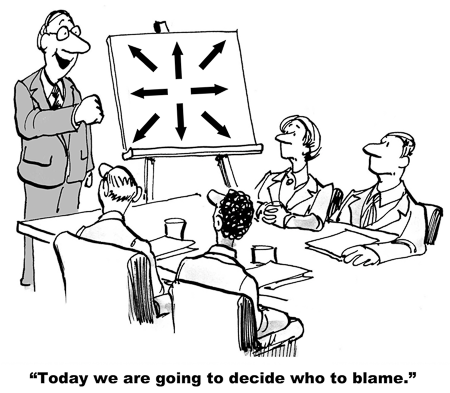Blame-Free Culture: Five Things to Ponder Before Adopting One
Five Things to Ponder Before Adopting One
A blame-free culture, along with just culture, caring culture, and learning culture, represents a set of approaches aimed at fostering a safer workplace by promoting open communication and accountability within safety management systems (SMS).
Much like zero-accident programmes, these workplace safety concepts often generate enthusiasm at the outset. However, as organisations encounter challenges in implementation, initial supporters may become sceptical, and these ideas risk fading into the background—another tool that, over time, blends into existing organisational safety culture without driving real change.
The reality is that workplaces are highly complex, and no single approach can single-handedly transform safety performance. A combination of factors—including workforce competency, technological advancements, operational risk management, financial pressures, and the broader regulatory environment—shapes workplace safety outcomes.
While certain strategies significantly enhance occupational health and safety (OH&S), they remain vulnerable to the effects of subcultures within and outside the organisation.
This article does not critique or oppose the adoption of a blame-free workplace. Instead, it highlights five critical factors that organisations should consider before integrating this approach into their safety management framework.
Beware of Hyperbolic Contrasts in Blame-Free Culture
The use of hyperbolic contrasts, whether deliberate or inadvertent, is common in organisational management. This occurs when the opposing viewpoint in an argument is exaggerated to an extreme.
In the case of blame-free culture, organisations that do not adopt it are often portrayed as having a culture where workers are blamed for every error—where everyone is terrified of speaking up, issues go unreported, the organisation fails to learn from near-misses, an accident eventually happens, and the injured person is then blamed, continuing the cycle.
While there are indeed organisations that operate in this way, it is not the norm. The reality is that many organisations strive to maintain a just system where issues can be reported without fear of reprisals, even if those fears occasionally become a reality.
Hyperbolic contrasts are often used to assign unrealistic super-qualities to an idea, making it appear more transformative than it truly is. In any case, a blame-free culture alone cannot drive meaningful change if other workplace factors contributing to an unsafe environment remain unaddressed.
Without a competent workforce, sufficient time, and financial resources to support organisational goals, blame-free policies add little value—the result will likely be failure.
Before adopting a blame-free culture, assess whether your organisation truly reflects the extreme version of a blame-centric culture being criticised. Temper your expectations, recognising that workplace subcultures play a significant role in accidents and losses. Simply shifting from blame to no-blame will not resolve deeper systemic issues.
Why Safety Systems Fail for Many Reasons
Much of the discourse around blame-free culture focuses on its role in preventing accidents and losses. However, it is important to recognise that accidents and losses occur for a wide range of reasons. Addressing the blame/no-blame aspect of workplace culture is necessary but insufficient on its own to drive meaningful improvements.
There have been numerous cases of major accidents arising from teams or organisations operating at the edge of their competence. From the thalidomide disaster to the reckless use of asbestos and lead, to space rocket explosions and failures in infection control during the COVID-19 pandemic, organisations have often struggled when navigating uncharted territory.
In all these cases, both blame-centric and blame-free cultures failed, as the blame dynamic within entire industries and sectors was largely irrelevant to these challenges.

With hindsight, we can analyse these cases and pinpoint how they could have been handled differently. However, that does not change the fact that competence, resources, and other systemic factors played a significant role in these failures.
There have also been numerous cases of major disasters directly linked to system failures stemming from poorly developed safety cultures. Again, the blame/blame-free aspect of these cultures is just one part of the broader cultural shortcomings that contributed to these disasters.
By taking a holistic view of the organisation and its broader objectives, the relevance of shifting towards a less blame-oriented culture becomes clearer. However, it should be seen as part of a wider strategy rather than a panacea for accident and loss reduction.
How Discipline Reduces Workplace Errors
From professional athletes to soldiers and even surgeons, the role of discipline in reducing errors cannot be overstated. Discipline is the art of gaining mastery, achieved through repetition among other methods. Dancers and musicians practise tirelessly, repeating their craft over and over until they perfect it.
For those who have mastered discipline, blame is simply a tool that is used judiciously in the pursuit of perfection. If the saying goes, "A bad workman blames his tools", then who does the good workman blame? Or does the good workman not engage in blame at all?
It is important to distinguish between opportunistic blame—where individuals shift responsibility to save themselves—and the judicious use of blame and discipline in reducing errors and striving for mastery.
A team working with a new lifting process, for example, is bound to make mistakes. The strength of a safety management system lies in how new activities are managed to ensure that the almost inevitable errors do not result in accidents and losses.
In developed safety cultures, the error-prone nature of new activities is recognised. As a result, greater emphasis is placed on implementing strong controls for such activities rather than focusing solely on blame or no-blame.
Before embarking on a blame-free transformation, consider the robustness of your safety management system and the current state of your organisational culture. Are your teams adaptable, resilient, and disciplined enough to thrive in new operating environments? These questions are at least as important as whether your organisation adopts a blame or blame-free culture.
Blame-Free vs Just Culture: Workplace Complexity
Far from being a panacea for accident and loss reduction, the introduction of a blame-free culture inherently triggers changes across other aspects of an organisation's culture as a whole.
Each subculture within an organisation is shaped by a combination of principles, assumptions, predispositions, and actions associated with various sections of its operations. A for-profit organisation, for example, is built on specific principles and assumptions that shape how team members approach financial matters. Changes in one subculture, such Safety culture, inevitably influence actions and predispositions in other areas.

Shifting to a blame-free safety culture will therefore impact human resource culture, operational culture, and innovation culture—some changes will be positive, while others may be negative. As these subcultures evolve, they, in turn, influence the safety culture once again, creating a dynamic and ongoing process of change.
For instance, the introduction of a blame-free culture could foster a more innovative workplace, encouraging greater risk-taking. However, increased risk-taking could push the organisation into unfamiliar operational territory, where only resilient and adaptive organisations can thrive. If not carefully managed, implementing a blame-free culture could inadvertently lead to greater risks and an increase in accidents or losses.
Furthermore, applying a blame-free approach solely to safety matters is unlikely to succeed, as operations may struggle to adapt to a culture where blame is removed in some aspects of the operation but retained in others. Transforming into a blame-free culture is a complex, organisation-wide shift that requires systemic change beyond what a safety practitioner alone can deliver.
Why Blame-Free Policies May Not Fit Your Industry
Operations exist within wider environments that shape their evolution. These operating environments are inherently complex and fluid. When layered upon intricate organisational structures, interwoven connections, and individuals striving to achieve multifaceted goals, the depth of complexity becomes evident.
Beyond their complexity—or perhaps because of it—operating environments are rarely blame-free. Organisations operate under government regulations, media scrutiny, public opinion, investor concerns, and competitive pressures.
Expecting all these interests to align and collectively embrace a blame-free approach is an unrealistic expectation.
Regulations are often designed with a binary structure to ensure effectiveness—many are bimodal, with clear-cut compliance or non-compliance. Legal prosecutions tend to be definitive—either an organisation complied, or it did not. The media, driven by sensationalism, rarely engages in nuanced evaluations—blame attracts attention and sells.
For the public, a company’s operations are typically perceived in stark terms—either beneficial or harmful. Investors prioritise profit and view losses with disinterest or concern.
Operating a blame-free culture within a broader environment steeped in blame-centric subcultures is a complex endeavour. Its true impact cannot be accurately measured by marginal reductions in accident rates over a short period.
In all, a blame-free culture is an integral part of a developed safety culture. Developed safety cultures emerge over time in organisations that operate effective safety management systems. These systems are designed to maintain discipline in familiar operations, resilience in chaotic and emergency situations, and adaptability in uncharted operational spheres.
The development and operation of a robust safety management system is, therefore, the true panacea for accident reduction—not the adoption of blame-free cultures alone. Over time, effective safety management systems foster a developed safety culture, of which a blame-free approach is merely a subset.
Frequently Asked Questions
A blame-free culture is an approach that encourages open reporting of safety incidents, errors, and near-misses without fear of punishment. It aims to foster a learning-oriented environment where the focus is on improving workplace safety rather than assigning blame.
In ISO 45001 safety management systems, a blame-free culture supports proactive hazard identification, encourages transparent communication, and promotes continuous improvement in occupational health and safety (OH&S).
- Enhances workplace trust and reporting culture.
- Encourages learning from mistakes to prevent future incidents.
- Supports root cause analysis rather than punitive action.
However, a blame-free culture should be balanced with accountability to maintain safety discipline.
A blame-free culture brings several advantages to workplace safety and organisational performance. Key benefits include:
- Increases incident reporting, leading to better risk assessment.
- Encourages open dialogue and fosters a stronger safety culture.
- Prevents a fear-driven work environment that discourages reporting.
- Improves employee engagement and team collaboration in hazard identification.
- Supports ISO 45001 compliance by aligning with safety management principles.
By shifting the focus from blame to learning and process improvement, organisations can build a more resilient and proactive safety culture.
While blame-free cultures offer many benefits, they also present challenges that organisations must address:
- Risk of reduced accountability, where serious safety violations are not properly addressed.
- Potential for misuse, where employees use it to avoid responsibility for repeated safety lapses.
- Resistance from leaders or employees accustomed to traditional disciplinary structures.
- Difficulty in defining the boundary between justifiable errors and negligence.
- External factors such as regulatory compliance requiring accountability measures.
Successful implementation requires a balanced approach, ensuring that learning and accountability go hand in hand.
In ISO 45001, a blame-free culture aligns with the principles of risk-based thinking and continuous improvement. It supports:
- Encouraging worker participation in hazard identification and risk control.
- Fostering a learning culture that aligns with Section 5: Leadership & Worker Involvement.
- Promoting transparent safety communication within the organisation.
- Reducing underreporting of incidents, which can hinder effective risk assessment.
However, ISO 45001 also requires clear accountability mechanisms, so organisations must ensure a balanced approach rather than a purely blame-free model.
Achieving a balanced approach to a blame-free culture involves integrating learning-focused policies with structured accountability.
- Define clear reporting guidelines to distinguish between errors and negligence.
- Use root cause analysis to ensure corrective actions focus on systemic issues, not individuals.
- Implement training and reinforcement measures to encourage safe behaviours.
- Develop just culture policies where repeated violations lead to progressive accountability.
- Align policies with ISO 45001 safety objectives for long-term sustainability.
By balancing learning and accountability, organisations can create a safer and more resilient work environment.
For insights into effective safety culture development, just culture frameworks, and organisational risk assessment, see other insights below. And for our data-driven safety metrics solutions visit our Solutions Page and sign up for a free trial account.